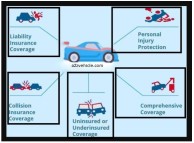Car insurance is an important way to protect yourself and your vehicle in case of an accident or other unforeseen events. There are several different types of car insurance coverage available, each of which offers different levels of protection. Here are the main types of car insurance coverage you should be familiar with:

- Liability coverage: Liability coverage is the most basic type of car insurance coverage and is required in most states. It covers damages or injuries you cause to other people or their property in an accident that you are found to be at fault for. This coverage typically includes both bodily injury liability and property damage liability.
- Collision coverage: Collision coverage is an optional type of car insurance that covers the cost of repairing or replacing your own vehicle in the event of an accident. This coverage applies regardless of who was at fault for the accident.
- Comprehensive coverage: Comprehensive coverage is another optional type of car insurance that covers damages to your vehicle from non-collision events, such as theft, vandalism, or weather-related damage.
- Personal injury protection (PIP): Personal injury protection, or PIP, is a type of car insurance coverage that covers medical expenses and lost wages for you and your passengers in the event of an accident, regardless of who was at fault.
- Uninsured/underinsured motorist coverage: Uninsured/underinsured motorist coverage is an optional type of car insurance coverage that provides protection if you are in an accident with a driver who either does not have any insurance or does not have enough insurance to cover the damages.
- Gap insurance: Gap insurance is an optional type of car insurance coverage that covers the difference between the actual cash value of your vehicle and the amount you owe on it in the event of a total loss.
When choosing car insurance coverage, it’s important to consider the following factors:
- State requirements: Check your state’s requirements for minimum car insurance coverage, as each state has different requirements.
- Your driving habits: Consider your driving habits, including the amount of time you spend on the road and the type of driving you do, such as highway driving or city driving.
- Your vehicle: The age, make, and model of your vehicle can affect the type of coverage you need.
- Your budget: Consider how much you can afford to pay for car insurance premiums and choose coverage accordingly.
- Your risk tolerance: Consider how much risk you are willing to take on in the event of an accident and choose coverage that provides the level of protection you feel comfortable with.
By understanding the different types of car insurance coverage available and considering these factors, you can choose the right coverage to protect yourself and your vehicle.


